Cebu City
| Cebu City Dakbayan sa Sugbo |
|||
|---|---|---|---|
| — City — | |||
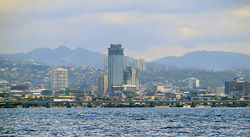 |
|||
|
|||
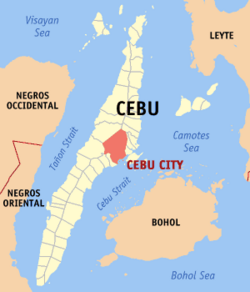 |
|||
| Coordinates: | |||
| Country | Philippines | ||
| Region | Central Visayas (Region VII) | ||
| Province | Cebu (capital) | ||
| Districts | First (North) and Second (South) districts of Cebu City | ||
| Barangays/Barrios | 80 | ||
| Spanish colonial foundation | 1565 | ||
| Reincorporated city | February 24, 1937 | ||
| Government | |||
| - Mayor | Michael Rama (BOPK–Liberal) | ||
| - Vice Mayor | Joy-Augustus G. Young (BOPK–Liberal) | ||
| Area | |||
| - Total | 315.0 km2 (121.6 sq mi) | ||
| Elevation | 17.0 m (56 ft) | ||
| Population (2007) | |||
| - Total | 798,809 | ||
| - Density | 2,536/km2 (6,568.2/sq mi) | ||
| Time zone | PST (UTC+8) | ||
| Area code(s) | 32 | ||
| Website | www.cebucity.gov.ph | ||
Cebu City (Cebuano: Dakbayan sa Sugbo) is the capital city of Cebu and the second city in the Philippines, the second most significant metropolitan centre in the Philippines and known as the oldest city established by the Spaniards in the country.
The city is located on the eastern shore of Cebu and was the first Spanish settlement in the Philippines. Cebu is the Philippines' main domestic shipping port and is home to about 80% of the country's domestic shipping companies. Cebu also holds the second largest international flights in the Philippines and is a significant centre of commerce, trade and industry in the Visayas and Mindanao region. According to the 2007 Philippine census, the city has a population of about 798,809 people.
Cebu City is the centre of a metropolitan area called Metro Cebu, which includes the cities of Mandaue, Lapu-Lapu and Talisay. Metro Cebu has a total population of about 2 million people. The Mactan-Cebu International Airport, located in Lapu-Lapu City is only a twenty-minute drive away from Cebu City. To the northeast of the city are Mandaue City and the town of Consolacion, to the west are Toledo City, the towns of Balamban and Asturias, to the south are Talisay City and the town of Minglanilla. Across Mactan Strait to the east is Mactan Island where Lapu-Lapu City and an aquarium attraction are located.
Contents |
History

In the 16th century, Cebu City was an area part of the Rajahnate of Cebu with an Islamic, Hindu and Animist populations. On April 7, 1521, Portuguese explorer Ferdinand Magellan landed in Cebu. He was welcomed by Rajah Humabon, the King of Cebu, who together with his wife and about 700 native islanders, were baptized by the Spaniards on April 14, 1521. Magellan, however, failed to successfully claim the Philippines for the crown of Spain, having been killed by Datu Lapu-Lapu, a king in Mactan Island on April 27, 1521 in the Battle of Mactan. On April 27, 1565, Spain colonized the area with the arrival of Spanish explorers led by Miguel López de Legazpi, together with Augustinian Friar Andrés de Urdaneta, sailing from Mexico, arrived in Cebu. The Spaniards established settlements, trade flourished and renamed the city on January 1, 1571, from San Miguel (Saint Michael) to Villa del Santísimo Nombre de Jesús (Village of the Most Holy Name of Jesus). During this six year period of exploration and settlements by the Spaniards, Cebu City was the capital of the Spanish East Indies. In 1898, the city was ceded to the United States after the Spanish-American War and Philippine-American War. In 1901, the city was governed by the United States for a brief period, however it attained the status of a charter city in 1936 and was governed independently by Filipino politicians. Following the end of the Japanese occupation in World War II, the city gained independence from colonial rule in 1946 as part of the Republic of the Philippines.
Culture

Cebu City is a significant cultural centre in the Philippines. The city's most famous landmark is Magellan's Cross. This cross, now housed in a chapel, was supposedly planted by Ferdinand Magellan when he arrived in the Philippines in 1521. It was encased in hollow tindalo wood in 1835 upon the order of the Augustinian Bishop Santos Gómez Marañon to prevent devotees from taking it home chip by chip. The same bishop restored the present template or kiosk, located at the present Magallanes street between the City Hall and Colegio del Santo Niño. Revered by Filipinos, the Magellan's Cross is a symbol of Christianity in the Philippines.
A few steps away from the Magellan's Cross is the Basilica Minore del Santo Niño (Church of the Holy Child), an Augustinian church which was elevated to the rank of Basilica in 1965 during the 400th year celebrations of Christianity in the Philippines, held in Cebu. The church, which was the first to be established in the islands. It is built of hewn stone and features the country's oldest relic, the figure of the Santo Niño de Cebu (Holy Child of Cebu).
This religious event is celebrated on the islands cultural festivities known as the Sinulog festival, held every third Sunday of January which celebrates the festival of the Santo Niño, who was formerly considered to be the patron saint of Cebu, until the patronage was changed to that of Our Lady of Guadalupe after it was realised that the St. Nino could not be a patron saint because he was an image of the Christ and not a saint. The Sinulog is a dance ritual of pre-Hispanic indigenous origin. The dancer moves two steps forward and one step backward to the rhythmic sound of drums. This movement resembles somewhat the current (sulog) of the river. Thus, the Cebuanos called it Sinulog.
When the Spaniards arrived in Cebu, the Italian chronicler, Antonio Pigafetta, sailing under convoy with the Magellan expedition, offered, as a baptismal gift, to Hara Amihan, wife of Rajah Humabon and later named Juana, the figure of the Santo Niño. The natives likewise honored the Santo Niño de Cebu in their indigenous Sinulog ritual. The Sinulog ritual was preserved but limited to honoring the Santo Niño. Once the Santo Niño church was built in the 16th century, the Christian Malay people started performing the Sinulog ritual in front of the church, the devotees offering candles and indigenous dancers shouting "Viva Pit Señor!" (Hail Mister).
In the 1980s and 2000s, the city authorities of Cebu made the Sinulog Festival part and parcel of the religious feast of the Santo Niño de Cebú to its cultural event.
Government

Cebu City is an independent and chartered city. Registered voters of the city cannot vote for provincial candidates unlike its nearby counterparts (Mandaue and Talisay cities) that form part of Metro Cebu. It is the capital of the province mainly because the provincial capitol is located in it. There were proposals however during the time of Governor Emilio Mario Osmeña to establish an "administrative district" that would be independent from Cebu City. This would literally mean carving out Cebu City's Barangay Capitol where the provincial capitol and other provincial offices are located. The plan however didn't push through and was even followed by other proposals like the transfer of the capital to Balamban.
Cebu City is governed mainly by a city hall, composed of one mayor, one vice-mayor and sixteen councilors (eight representing the northern and eight representing the southern region). Each official is elected publicly to a three year term. The chief of the Association of Barangay Captains and the President of the Sangguniang Kabataan Federation also managed in the city council. The day to day administration of the city is handled by a city administrator.
Michael Rama is the mayor of Cebu City. The former vice mayor, he was elected during the 2010 Philippine elections. Joy-Augustus G. Young is the vice mayor.[1][2]
2010 Local Elections
| POSITION | CANDIDATE | PARTY | TOTAL VOTES |
|---|---|---|---|
| Representative 1st District |
Rachel Marguerite B. Del Mar | BOPK–Liberal |
|
| Representative 2nd District |
Tomas D.R. Osmeña | BOPK–Liberal |
|
| City Mayor | Michael Rama | BOPK–Liberal |
|
| City Vice Mayor | Joy-Augustus G. Young | BOPK–Liberal |
|
| City Councilors | |||
| 1st District (North) | |||
| Edgardo C. Labella | BOPK–Liberal |
|
|
| Augustus G. Pe Jr. | BOPK–Liberal |
|
|
| Alvin B. Arcilla | BOPK–Liberal |
|
|
| Sisinio M. Andales | BOPK–Liberal |
|
|
| Lea Ouano-Japson | BOPK–Liberal |
|
|
| Alvin M. Dizon | BOPK–Liberal |
|
|
| Noel Eleuterio G. Wenceslao | BOPK–Liberal |
|
|
| Ma. Nida C. Cabrera | BOPK–Liberal |
|
|
| 2nd District (South) | |||
| Rodrigo A. Abellanosa | BOPK–Liberal |
|
|
| Margarita V. Osmeña | BOPK–Liberal |
|
|
| Eduardo R. Rama Jr. | BOPK–Liberal |
|
|
| Jose C. Daluz III | BOPK–Liberal |
|
|
| Raul D. Alcoseba | BOPK–Liberal |
|
|
| Ronald R. Cuenco | BOPK–Liberal |
|
|
| Richard Z. Osmeña | BOPK–Liberal |
|
|
| Roberto A. Cabarrubias | BOPK–Liberal |
|
|
Economy
Cebu City is considered as one of the most progressive cities in the Philippines. About 80 percent of the island vessels operating in the country are also based there. Recently, the entry of business process outsourcing (BPO) firms such as call centres have contributed much to the growth of the local economy. During the last years of the 1980s, growth has been spread to the countryside. Thus the name Queen City of the south was given to Cebu City. For Central Visayas, where Cebu or "Ceboom" belongs, it is again the industrial sector that holds much promise. Aside from shellcrafts, rattan furnitures and stonecraft, tourism may well rake in dollars. BPO sites are scattered throughout the city. The city is now known as the top emerging site of BPO in the world.
Geography and People
| Population Census | |||
|---|---|---|---|
| Census | Pop. | Rate | |
| 1995 | 662,299 |
|
|
| 2000 | 718,821 | 1.77% | |
| 2007 | 798,809 | 1.47% | |
Cebu City has a land area of 291.2 square kilometres and about 55.9 square kilometres is classified as urban, while 235.2 square kilometres is classified as rural, although all barangays are classified as urban. To the northeast of the city are Mandaue City and the town of Consolacion, to the west are Toledo City, the towns of Balamban and Asturias, to the south are Talisay City and the town of Minglanilla. Across Mactan Strait to the east is Mactan Island where Lapu-Lapu City is located. Further east across the Cebu Strait is the Island of Bohol.
Around 1960's the population of the city was just around 91,000. The current data shows that the population reached 798,809 people in 2007.
The city is politically subdivided into 80 barangays or barrios. These are grouped into two congressional districts, with 46 barangays or barrios in the northern district and 34 barangays or barrios in the southern district.
Barangays
Cebu City is politically subdivided into 80 barangays.
North district
|
South district
|
Infrastructure
The Cebu Metropolitan Area has all the necessary infrastructures sufficient enough for its pace of urbanization. The city is readily accessible by air via the Mactan-Cebu International Airport located in Lapu-Lapu City which has direct international flights to Hong Kong, Singapore, Japan, China, Palau, Malaysia, Taiwan, Qatar, South Korea and other domestic destinations. There are many international and cargo airlines flying to Cebu, such as Cathay Pacific, Silk Air, Malaysia Airlines, Qatar Airways, Korean Air, Jeju Air, China Southern Airlines, Asiana Airlines, China Airlines, China Eastern Airlines and FedEx, 2GO, Pacific East Asia Cargo Airlines respectively. There are also direct transfer flights via the capital's Ninoy Aquino International Airport that readily connects the city to other destinations in the world. The city mostly gets its power from an interconnection grid with the Leyte Geothermal Power Plant which also powers the majority of the Visayas Islands. There are also coal-fired power plants though these have been controversial due to its impact to the environment. Another coal-fired power plant is nearing completion and is envisioned to make the city independent from the interconnection grid once completed. Distribution of electricity is provided by the Visayas Electric Company (VECO).
The city is served by a domestic and international port which are handled by the Cebu Port Authority. Much of the city's waterfront is actually occupied by the port with around 3.5 kilometres of berthing space. The domestic port readily gives access to nearby islands and provinces. The city's central location makes it an ideal shipping hub. It is also home to more than 80% of the country's island vessels traveling in domestic routes mostly in the Visayas and Mindanao.
The South Road Properties (SRP)is a 300-hectare prime property development project on a reclaimed land located a few metres off the coast of Cebu's central business district. It is registered with the Philippine Economic Zone Authority (PEZA) and is funded by the Japan Bank for International Cooperation(JBIC).[3] Traversing the property is a 12 kilometres, four-lane highway known as the Cebu Coastal Road that provides the motorists with a good view of Cebu's south coast and the nearby island of Bohol.
Telecommunication facilities, broadband and wireless internet connections are available and are provided by some of the country's largest telecommunication companies.
In the 1990s the Inayawan Sanitary Landfill was constructed to ease garbage disposal within the city. It is however nearing its lifespan although the Provincial Government is planning to build two sanitary landfills to serve both the northern and southern parts of Metro Cebu including Cebu City. In June 2005, the city fully implemented the segregation of wastes as mandated by law.
Mass transportation throughout the city and the metropolitan itself is provided by jeepneys, buses and taxis. There were previous plans of setting up a mass railway system but it was deemed not feasible as of the moment due to the high construction cost that it will entail and the uncertainty of making the routes profitable.
Education
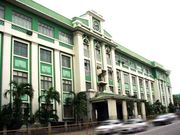

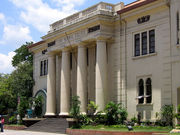
Cebu City is one of three centres of education in the country, the other is being the Manila Metropolitan Area and Metropolitan Davao. It currently has nine large universities each with a number of college branches throughout the city and more than a dozen other schools specializing in various courses such as Medicine, Engineering, Nautical courses, Nursing, Law, Computer and IT and among others.
Among these schools is the oldest educational institution in the Philippines, the University of San Carlos. It has four campuses around the metropolitan area. Before gaining university status, it was originally called Colegio de San Ildefonso and was established in 1595 by the Jesuits. It is currently headed by the Society of the Divine Word.
The University of the Philippines, Visayas, located at Camputhaw in the district of Lahug in Cebu City currently has 8 courses and has plans of expansion and development.
Another catholic university in Cebu City is the University of San José - Recoletos which was established in 1947. It is currently headed by the Augustinian Recollects and has 2 different campuses within the city excluding a new campus outside the city located in the Municipality of Balamban.
Cebu Normal University was established in 1915 as a provincial normal school, a branch of the Philippine Normal School. It became an independent institution in 1924, a chartered college in 1976 and a university in 1998. It is one of the oldest educational institutions in Cebu City.
One of the newest universities which is the Cebu Doctors' University (formerly Cebu Doctors' College) was granted university status on November 2004. It is the only school in the Philippines declared as a university without having basic education (pre-school - high school) curriculum and catering mainly to courses related to the health services field. It has just recently relocated to a nine-storey main building at the Cebu Boardwalk in neighboring Mandaue City thus closing its old campus near the then Cebu Doctors' Hospital (now Cebu Doctors' University Hospital).
The Cebu Institute of Medicine is one of the five recognized Centers of Excellence in the Philippines, and recently adopted the Problem Based Learning (PBL) Method. Its over-all passing percentage in the Philippine Medical Board Examination is 95.37% from 1994–1998 and 100% in the August 2007 Examination.
The University of Cebu in Banilad opened in June 2002, first had a modern eight-storey building. With the projected increase in enrollment in SY 2004-2005, a nine-storey building was constructed in the same area. This is one of the colleges that the University of Cebu have. The University of Cebu's main college offers a variety of courses such as Bachelor of Science in Information Technology (BSIT), HRM, Computer Engineering, BSED and others.
Also located in the city is the University of the Visayas (the first-ever university in the city and in the entire province).
Other noteworthy institutions in the city includes Velez College, Southwestern University, the Cebu Institute of Technology – University (the newest university in the city), the University of Southern Philippines Foundation in Lahug and Mabini, and the Cebu Technological University (formerly the Cebu State College of Science and Technology).
Many foreign students also travel to Cebu City to study. Most of them are Iranians and Nepalese who are studying medical courses. In recent years, many Koreans have come to Cebu to study English.
Cebu City has 68 public elementary schools, 23 national high schools and 28 night high schools. These night high schools are operated by the city government.
Tourism
Tourism continues to contribute much to the city's economy, not just of the city itself, but to the entire province. Because of this, the city hosted the 1998 ASEAN Tourism Forum. The city also hosted the East Asian Tourism Forum on August 2002, in which the province of Cebu is a member and signatory.
On early 2007, Cebu Plaza hotel was formally reopened under a new name, Marco Polo Plaza, after more than two years of closure. The hotel complex was formerly occupied by Cebu Plaza which was the first deluxe hotel in the province. It opened in the early 1980s and was viewed by some as a symbol of the province's economic growth.
There are a number of significant Spanish colonial buildings in Cebu City, including the Basilica Minore del Santo Nino, Fort San Pedro, Casa Gorordo Museum and Magellan's Cross.[4]

There are a number of shopping centres in the city, the most popular of which are the SM City Cebu, Ayala Center Cebu, Robinsons Plaza and Gaisano Malls. There are also other smaller shopping centres and stand-alone department stores. Throughout the years however, the establishment of large shopping centres offers some sort of a town centre environment which have become popular. Recent development and expansion of existing shopping centres have also given the shoppers a new variety of choices in the city such as SM Cebu's "Northwing", a multi-level annex building with multilevel parking and Ayala Center Cebu's "Leisure Oasis", a development that consists of redefining Cebu's shopping experience through the newly re-designed Ayala Shopping complex. There is also the Carbon Market, a farmer's market in the city and the famous "Dried Mango" food.
Away from the city, is the Cebu Taoist Temple, a Buddhist temple situated in Beverly Hills. The Taoist Temple gives a commanding view of Cebu City and the nearby cities of Mandaue and Lapu-Lapu. Views of Cebu City can also be seen from villages and gated communities located on the mountains.
The Cebu Reggae Festival is a popular Filipino Reggae and Roots music festival, it now has become one of the Philippines's largest annual Reggae Festivals, in Cebu City. The city also has a sport institution, the Cebu City Sports Complex which exhibits sporting and festival events.
Sister cities/towns
|
References
- ↑ "Davide is acting Cebu City mayor Osmeña in US, Rama off to Korea". INQUIRER.net. http://globalnation.inquirer.net/cebudailynews/news/view/20081010-165704/Davide-is-acting-Cebu-City-mayor. Retrieved 10 October 2008.
- ↑ "Osmeñas leave for US amid prayer". INQUIRER.net. http://globalnation.inquirer.net/cebudailynews/news/view/20081008-165293/Osmenas-leave-for-US-amid-prayers. Retrieved 8 October 2008.
- ↑ "The Official Cebu City Government Forum". Republic of the Philippines: Cebu City Government. http://www.cebucity.gov.ph/srp/srp.htm. Retrieved 12 January 2010.
- ↑ Department of Tourism Philippines official website page on Cebu. Accessed 28 September 2009.
External links
|
|||||
|
|||||||||||
|
|||||||||||
| Leading population centers | |||||||
|---|---|---|---|---|---|---|---|
| Rank | City | Population | Pop. Growth Rate | Region | 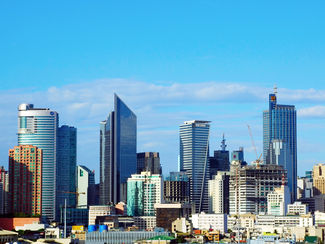 Metro Manila  Cebu City |
||
| 1 | Quezon City | 2,679,450 | 2.53% | National Capital Region | |||
| 2 | Manila | 1,660,714 | 0.03% | National Capital Region | |||
| 3 | Caloocan | 1,378,856 | 2.53% | National Capital Region | |||
| 4 | Davao City | 1,363,337 | 1.81% | Davao Region | |||
| 5 | Cebu City | 798,809 | 2.16% | Central Visayas | |||
| 6 | Zamboanga City | 774,407 | 3.54% | Zamboanga Peninsula | |||
| 7 | Antipolo | 633,971 | 5.22% | CALABARZON | |||
| 8 | Pasig | 617,301 | 2.29% | National Capital Region | |||
| 9 | Taguig | 613,343 | 4.07% | National Capital Region | |||
| 10 | Valenzuela | 568,928 | 2.23% | National Capital Region | |||
| based on the Philippines 2007 Census | |||||||

